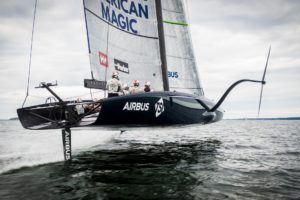
New Airbus battery lab to push battery technology in Shenzhen
NEW DELHI:From mobile phones to electric cars, batteries have transformed our lives. Yet much of their potential remains untapped. In China, the recently opened Airbus China Innovation Centre battery lab is looking to unleash this potential to power a new generation of electric-powered aerial vehicles.
For anyone who has ever used a mobile phone or laptop computer, there is no doubt batteries have transformed our lives. And thanks to major technology advancements in recent years, today’s batteries are smaller and more powerful than ever before, which continues to broaden their use.
Lithium-ion batteries—the most cutting-edge and widely used battery technology in the world—have become 5-10% more efficient each year since their introduction in the 1970s. This has helped to spur the mass adoption of portable electronic devices, and is turning the dream of affordable electric vehicles (EVs) into reality. According to recent estimates, EVs are expected to account for almost a third of global car sales by 2025. As a result, the global demand for lithium-ion batteries has exploded, growing more than 700% since 2010.
“Better batteries will help to enable tomorrow’s aerial vehicles. New urban air vehicles, as seen in the case of Vahana and CityAirbus, will require batteries that are not only extremely light and powerful, but also reliable and cost efficient,” said Mustang Guo, ACIC Project Manager.
Today, Asia is the global epicentre of battery development and production, with Japan and Korea as the worldwide leaders. However, a new player is rapidly catching up to the traditional heavyweights: China. In fact, China’s ascension to battery development superpower has been vertiginous: the country is expected to produce 70% of the world’s EV batteries by 2021.
This is why Airbus has selected the Airbus China Innovation Centre (ACIC) in Shenzhen as the location for a new battery lab. Opened in August 2019, the lab will not only tap into the rich ecosystem of Shenzhen—China’s tech hub—but also into the ecosystem across China and Asia to test batteries for a range of applications, from electric propulsion to electrical systems.
Supercharged: pushing battery technology to the limit
Despite the impressive progress made in recent decades, the untapped potential of batteries still remains significant. This includes the development of new materials and chemical combinations. The ACIC battery lab is focused on tapping into these possibilities, in addition to running safety and durability tests, and finding solutions to long-standing battery challenges.
One challenge is thermal runaway. Thermal runaway is an unstoppable chain reaction in a battery that causes rapid overheating and can lead to fire. It is rare, but can happen to computers or phones. In 2016, millions of electronic devices had to be recalled after a battery fault caused units to overheat and explode. Although lithium ion is considered the most effective technology currently available for rechargeable batteries, the battery recalls are a reminder that it is not without safety concerns, which limits its use in aviation.
To develop new battery solutions that can be applied to commercial aviation, the ACIC team will collaborate with local partners in Shenzhen, including BYD, one of the world’s largest electric vehicle and battery makers. The team will also work closely with the Airbus Battery CoC, the TEIE team in Toulouse that develops new battery solutions for aerospace applications.
“Having a battery lab in China is the perfect complement to our electrical lab in Toulouse,” says Valéry Gineste, Head of TEIE.
“The ACIC lab will focus on testing the latest cells and battery technologies to emerge from China, which will reduce time to market,” he added.
Better batteries to power tomorrow’s aerial vehicles
If the aviation industry is to drive progress on the electrification of flight, improving the safety and performance of batteries is crucial. Specifically, the success of urban air mobility and hybrid-electric future aircraft hinges on the development of high-performance and safe battery technology. This is a core focus for the ACIC battery lab, which will work to develop batteries for electric propulsion, a prerequisite to power this new class of aerial vehicles.
“Better batteries will help to enable tomorrow’s aerial vehicles,” Mustang Guo, ACIC Project Manager, explains. “New urban air vehicles, as seen in the case of Vahana and CityAirbus, will require batteries that are not only extremely light and powerful, but also reliable and cost efficient.”
The ACIC battery lab will also look at how to safely replace nickel cadmium with superior lithium-ion batteries to power aircraft systems, without the need for restrictive heavy casing.
Further exploration areas will soon follow as the lab quickly ramps up the scope of its work to explore the wealth of untapped potential that batteries have to offer.

